Collection
M 198: |
Year this material was created:
1986-1988
Quantity: 46 original pen and ink drawings
©2004
by Fort Lewis College Foundation, Center of Southwest Studies account
Links to contents
|
||
Use note: this collection is reserved for the use of researchers who have a need for using these drawings in the course of scholarly research. The original drawings may only be used under the immediate supervision of a member of the professional archival / library staff of the Center of Southwest Studies. We have provided digital image access to all of the drawings; please follow the hyperlinks below to view those images. The digital images are protected by copyright and are provided here solely for research use and personal enjoyment.
Introduction/
Scope and contents
This page describes forty-six original black and white drawings of the rock art at Bandelier
National Monument that were drawn by Lisa Ferguson during the period 1986 to
1988 and were published in Rock Art of Bandelier National Monument (text
by Arthur H. Rohn; photographs by William M. Ferguson; drawings by Lisa
Ferguson; foreword by Richard B. Woodbury; published in Albuquerque by the
University of New Mexico Press, 1989).
See also the book, available in the Delaney Library at the Center of Southwest Studies and elsewhere. The call number is E99.P9 R64 1989.
Historical/ biographical note (under construction)
Administrative information
About the organization of this collection: These drawings are arranged numerically, by the author's drawing number.
Acquisition information: This is accession 2002:10007, which forms part of the Ferguson collection M 198 at the Center of Southwest Studies. Prior to the creator's donation of these original drawings to the Center in October of 2002, they were on loan to the Center (since November 19, 2001).
Processing information: Work on this collection was generously funded by cash gifts from Mr. William Ferguson and Mr. Mead Ferguson, relatives of the artist. To preserve the originals and to provide access to their content, the Center's archival staff have placed each drawing into an archival folder, have placed all of the items together in a lidded flat archival box, and have produced high-resolution digital images, accessible on this and the hyperlinked pages in lower-resolution thumbnail and access images.
This guide was produced by Todd Ellison, Certified Archivist, Center of Southwest Studies (November 2004), with the assistance of Gretchen Gray (web pages content completion), David Schiowitz (creation of the derivative jpeg files and insertion of those images into the pages with hyperlinks) and other student archival assistants at the Center, including Kali Willie, who produced the descriptive list in October of 2002. Digitization was by volunteer Ed Lederman, student intern Lloyd Poncho, and Todd Ellison.
Item-level description of the drawings
| # | Title | Description | Thumbnail picture and link to access image |
| 43 | Room Cluster V at Long House | Two concentrations of rock art occur in Room Cluster V. The panel of kachina masks decorates the back wall of the third floor dance plaza formed by the roots over Rooms 166/2 through 183/2. Here the occupants of this room cluster probably performed those rites important to the well being and identity of the group, and the adjacent rock art may reflect their legendary history. | 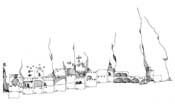 |
| 45 | Flat head kachina mask at Long House | This drawing of a simple kachina mask petroglyph occurs at the upper left of the mask panel above Room 166/2a. | 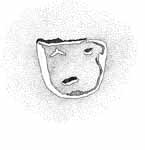 |
| 46 | Painted stick figure above Room 186/4 | This painted stick figure above Room 186/4 seems to represent a kachina holding a club in its left hand and a stick or short spear in its right. The line rising from its round head probably represents a feather. | 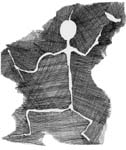 |
| 49 | Cliff above Room Cluster IV at Long House | The cliff above Room Cluster IV displays no rock art. However, the people who lived here built the only kiva found in Long House. Room 137 stood twice as tall as the other rooms and had been partially carved out of the rock. Its walls were once plastered and painted with colored murals, but today only scant traces of this plaster can be seen. |  |
| 50 | Room Cluster III at Long House |
Room Cluster III at Long House focused around the tall natural chimney in the cliff face in which its residents constructed their only three-story building—Room 127. On the cliff face of the upper story and above it they pecked seven kachina figures, a serpent, and a square with a cross inside it. | 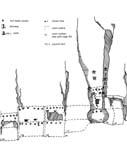 |
| 52 | "Ready" Crouch Kachina Figure at Long House | This petroglyph of a stick kachina-like figure has a triangular head, both arms raised, and outstretched legs in a “ready” crouch. | 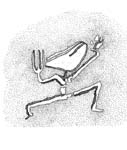 |
| 53 | Curved-legged Kachina Figure at Long House |
Petroglyph of a kachina-like figure above Room 127/3 with round head, arms extended to both sides, and legs curved upward towards the hands. | 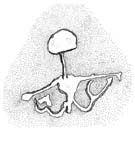 |
| 54 | Three-fingered Kachina Figure at Long House |
Petroglyph of a kachina-like figure above Room 127/3 with round head, broad body, both arms raised, three fingers on each hand, and outstretched legs. | 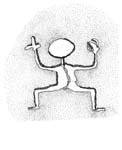 |
| 56 | Room Cluster II at Long House | The rooms in Room Cluster II show unusual uniformity in floor size and ceiling height. Their occupants stood on the roofs of their houses to inscribe on the cliff face the most impressive array of rock art figures found at Long House. | 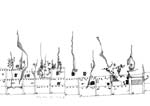 |
| 61 | One-feathered Kachina Figure at Long House | This pecked kachina figure above Room 85/2 has a large horseshoe shaped body, very short arms and legs, and one feather. | 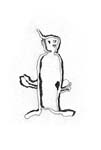 |
| 62 | Winged Kachina Figure at Long House |
This petroglyph above Room 85/2 represents either a kachina with wings or an angel. In the latter case, it would denote knowledge of Christianity following Spanish contact, the sole case we observed in Long House. | 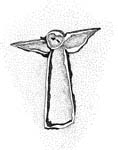 |
| 63 | Sad Kachina Figure at Long House | This petroglyph above Room 85/2 depicts a round headed kachina with sad face, distinct neck, broad body, upraised arms with four fingers on each large hand (perhaps extended toward viewer), and short legs with both feet pointing left. |  |
| 64 | Seated Kachina Figure at Long House | This elaborate kachina petroglyph appears to be seated to the left of the doorway into cave Room 81/3. Many feathers project from its rectangular head, while the neck and rectangular body have been sectioned. The right arm is raised and the left extends downward. |  |
| 65 | Stylized Serpent Pair, Room Cluster II at Long House |
The eight stylized serpent figures in the dance plaza panel of Room Cluster II all run vertically and usually occur in pairs. This pair above the east wall of Room 77/3 have a small rectangular headed kachina between them. | 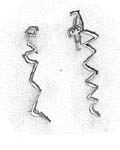 |
| 68 | Simple Ovoid Mask at Long House |
This simple ovoid mask with joined eyes decorates the back wall of Room 73/3 to the right of the doorway into the cave room behind. | 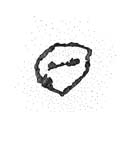 |
| 72 | The considerable length of Room Cluster I discloses two possible ceremonial zones, the most obvious a dance plaza on the roofs of seven second story rooms from Room 44/2 through 54/2 in front of an extensive rock art panel. The second zone runs along the narrow uneven ledge part way up the cliff face above Rooms 29 through 44, where a second panel of rock art occurs. This zone could be reached only by climbing up the steep ledge from the roof of Room 17/2. | [image file under construction: to be stitched for insertion here] | |
| 73 | Doorway at Room Cluster I at Long House | The densest concentration of rock art in Room Cluster I lies above Rooms 47/2 and 50/2 at the back of the dance plaza. It includes kachina figures, a kachina mask, serpents, and sets of concentric circles surrounding the doorway into cave Room 50/3. | 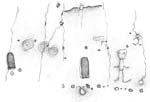 |
| 74 | Bunny-eared Kachina Mask, Room Cluster I at Long House |
This featureless round mask with “bunny” like ears or feathers may be seen on the back wall of Room 50/2. | 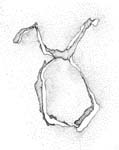 |
| 75 | Big-footed Kachina Figure, Room Cluster I at Long House |
The largest kachina figure in Room Cluster I, located to the right of the doorway into cave Room 50/3, has few distinguishing features—a large head with two very short feathers. Its arms project outward from what should be waist level, and its legs are straight with very big feet. |  |
| 76 | Three Rectangle-headed Figures at Long House | This close group of three rectangular headed figures just above and right of the doorway into cave Room 50/3 has been badly eroded. | 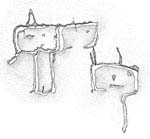 |
| 77 | Stylized Snake at Long House |
Highest on the cliff face above cave Room 50/3’s doorway is the pecked figure of a stylized snake that seems to be squeezing through a square. |  |
| 79 | Kachina-like Figure, Room Cluster I at Long House |
This round headed kachina-like figure with tiny body, arms, and legs may be found above Room 41/2. | 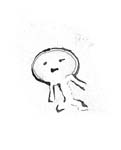 |
| 82 | Large Serpent, Room Cluster I at Long House |
The large serpent of the high ledge panel lies behind a circle or shield and has an L-shaped block on its tail. |  |
| 85 | Mudhead Kachina Head and Arms, Room Cluster I at Long House |
Only the head and arms of this Mudhead Kachina survive above the Room 61/2 in Room Cluster I. | 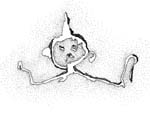 |
| 86 | Dancing Mudhead Kachina Figure, Room Cluster II at Long House |
This Mudhead Kachina seems to be dancing on the cliff face above the wall between Rooms 103/2 and 106/2 near the east end of Room Cluster II. | 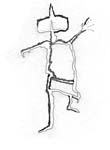 |
| 88 | Five-fingered Kachina Figure, Room Cluster II at Long House | This kachina figure to the left of the large niche above the west end of Room 73/3 in Room Cluster II seems to be jumping. Atypically, five fingers are shown on each hand. | 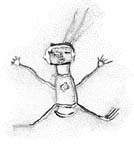 |
| 89 | Four-armed Kachina Figure, Room Cluster II at Long House | This squarish kachina figure above Room 73/3 in Room Cluster II appears to have four arms. | 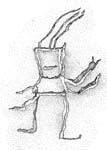 |
| 90 | Small Kachina Figure, Room Cluster III at Long House |
This small kachina figures typifies the detail shown on all the figures on the walls of the natural chimney above Room 127/3 in Room Cluster III. | 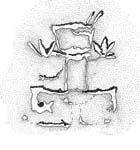 |
| 91 | Jumping Kachina Figure at Long House |
Yet another kachina figure above the east end of Room 50/2 has arms and legs extended as if jumping. | 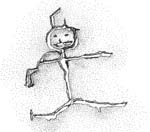 |
| 92 | Triangular Kachina Mask, Room Cluster V at Long House | Kachina masks exhibit all the same shapes as the heads on kachina figures except for the rectangular form. This triangular mask with eyes, nose, and mouth occurs in the center room above Room 166/2a as part of the mask panel in Room Cluster V. | 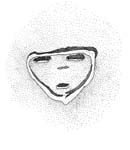 |
| 93 | Round Kachina Mask, Room Cluster V at Long House | This round kachina mask with facial features lies above and to the right of figure 92 above Room 166/2a in the mask panel of Room Cluster V. | 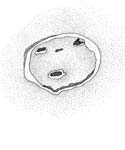 |
| 94 | Heart-shaped Kachina Mask, Room Cluster V at Long House | Heart shaped kachina masks occur rarely. This one with legs appears above Room 170/3 in the mask panel of Room Cluster V. | 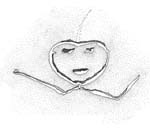 |
| 95 | Diamond Kachina Mask, Room Cluster II at Long House | This full featured diamond shaped kachina mask may be seen above Room 100/2 in Room Cluster II. | 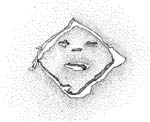 |
| 96 | Round Kachina Mask, Room 50/2 at Long House | Many Kachina masks, such as this round one above the east end of Room 50/2, have curved lines attached to them to symbolize feathers. | 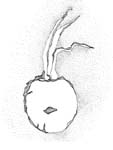 |
| 98 | Small Duck, Room 85/2 at Room Cluster II at Long House | A small duck waddles along the east end of Room 85/2 in Room Cluster II. | 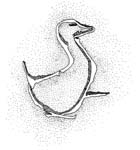 |
| 99 | Isolated Crow Figure, Room Cluster II at Long House | This isolated figure of a crow stands above and to the right of the doorway into cave Room 93/3 in Room Cluster II. | 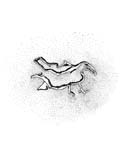 |
| 100 | Dove above Room 186/3 at Room Cluster V at Long House | The bird above Room 186/3 in Room Cluster V appears to be a dove. | 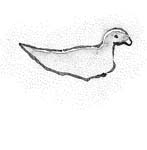 |
| 102 | Chipmunk above Room 65 at Room Cluster II at Long House | The small animal above the Squash Kachina over Room 65 in Room Cluster II appears to be a chipmunk. | 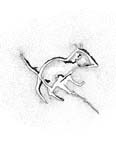 |
| 103 | Animal with Small Rectangular Figure, Room Cluster V at Long House | The animal facing a small rectangle headed kachina figure above Room 182/3 in Room Cluster V appears to have antlers, yet its body and head seem much too bulky for a deer, pronghorn antelope, or elk. |  |
| 104 | Serpent, West-end of Room Cluster I at Long House | This serpent figure above Room 5/2 near the west end of Room Cluster I in Long House clearly has a tail at the left and a head at the right even though parts of it have been damaged by erosion. |  |
| 105 | Snakehead, Room Cluster I at Long House | The snakehead above Room 23/2 in Room Cluster I shows unusual realism, even to the projecting tongue or fangs. Its body either has eroded or was never completed. | 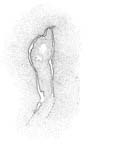 |
| 106 | Serpent, East Wall above Room 100/2 at Long House | Most serpents in Long House rock art have been stylized as horizontal zigzag lines with an ovoid of diamond shaped head such as this one above the east wall of Room 100/2 in Room Cluster II. |  |
| 110 | Zigzag Serpents, Room Cluster II at Long House | These two vertical zigzag lines above the west part of Room 85/2 in Room Cluster II have been interpreted as serpents because of the tight spirals at their upper ends. | 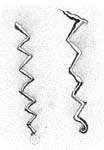 |
| 113 | Sun House Figure near top of Cliff above Talus House | Hewett labeled Sun House in Frijoles Canyon for this figure of a sun pecked high above the small talus ruin on the cliff face that could only be reached by descending a rock ledge from above. The animal above the sun symbol looks almost like a kangaroo rat, either standing in the background or jumping over the sun. | 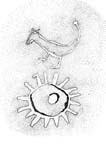 |
| 114 | Trio of Animals above Snake Kiva | This trio of animal forms was pecked onto the rock face near the top of the cliff high above Snake kiva in Frijoles Canyon. A serpent crawls along above a horse with wrappings around both its muzzle and tail and an imaginary animal with massive body and tail. Judging from their subject matter and style, these latter two figures were probably carved after the arrival of the Spaniards in 1540. |  |
| 115 | High Cliff Panel above Talus House | On yet another high cliff section above the Talus House in Frijoles Canyon stands a small panel of rock art. In the center is a circle with a coyote either balancing on top of it or holding it (a coyote baying at the moon?). A group of serpents and a possible bird complete this panel.B | 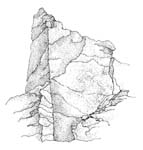 |
Doing your own research: This description of a portion of the collections at the Fort Lewis College Center of Southwest Studies is provided to inform interested parties about the nature and depth of the repository's collections. It cannot serve as a substitute for a visit to the repository for those with substantial research interests in the collections.
This collection is located at the Center of Southwest Studies on the campus of Fort Lewis College. Researchers wanting more information about using this material at the Delaney Southwest Research Library at the Center may email the archivist at archives@fortlewis.edu or click here to use our E-mail Reference Request Form (or phone the archivist at 970/247-7126). The Center does not have a budget for outgoing long-distance phone calls to answer reference requests, so please email if you wish to receive a response from the Center. To request reproductions/copies, click here for instructions.
